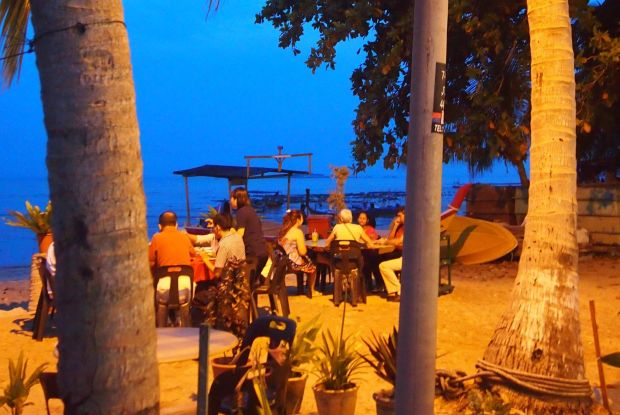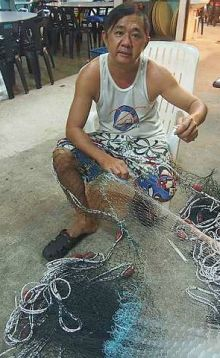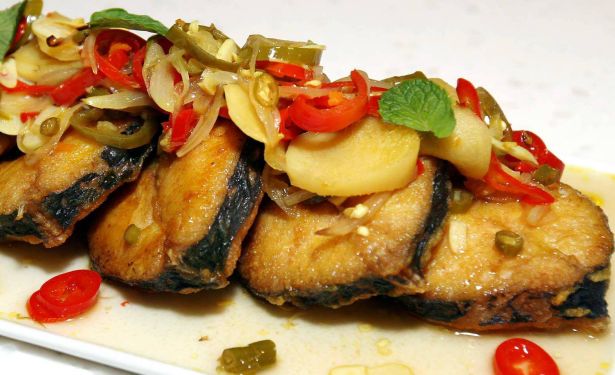Tsunami Village Café,
543-A Tanjung Bungah Road,
Penang.
Tel: 012-487 2718/019-447 2718
Business hours: 5.00pm-10.00pm,
closed on Mondays.
A small and unassuming eatery in Penang with a large repertoire of dishes.
AH TEIK watched on in horror and disbelief as the tables and chairs in his soon-to-be-opened outlet were being thrown about the place, and there was nothing he could do about it. The infamous tsunami of 2004 was claiming yet another victim – this time, it was his little home-based, beachside café in Tanjung Bungah, Penang.
We are sitting outside his new – well, fairly new – outlet just a few hundred yards from the old one, as he recounts that fateful day.
“At precisely 1.45pm on Dec 26 that year, a 200-300m large wave hit the building,” he recalls. Along with all his furniture and 13 boats, he also lost his garoupa farm which had been set up at sea. And although he did eventually start up a seafood steamboat outlet there, albeit a month later than planned, he finally moved to his current premises in mid-2005.
Named in memory of the catastrophic day that turned the world upside down, the Tsunami Village Café (“I didn’t even know the meaning of the word before!”) is nothing more than tables and chairs arranged in the back courtyard of one of those old houses which line the main Tanjung Bungah Road, covered with a simple aluminium roof.
If you prefer al fresco dining, then opt for one of the tables set up on the beach. Bar the odd mosquito, it really is quite pleasant sitting there enjoying the night air (they only open from 5pm), watching the fishing boats tethered nearby rock gently on the waves. In the background, the occasional soothing, plaintive call to prayers emanates from the muezzin in the nearby floating mosque.
It is your definitive local no-frills eatery, with barely a table cloth in sight, and the pork-free menu is just a simple plastic folder of some photocopied pages in Chinese script with English translations. This is also reflected in the prices: they are quite reasonable here.
The reason? “I am a fisherman as well as a wholesaler,” Ah Teik, 49, explained. The mechanic turned fisherman still goes out to sea himself every day, and can often be found at the back of the dining area in the evenings, repairing any tears to his net whenever he has a spare moment. It’s fascinating to see the way his skilled fingers weave the nylon string in and out.
A bit further out to sea, you can glimpse the outline of his new garoupa (kuey kow) farm, which also supplies fish to the outlet. Whatever his small fleet of boats brings in every day is either sold or swapped with other fishermen so he claims that, without the need for middlemen, it is slightly cheaper to eat at his place than in other restaurants. This would probably account for the large groups, both local and expatriate, who gather around the tables tucking into his food every evening.
Once you have picked what you want: lobsters, prawns, fish, mantis prawns (lai liew har), mud (chim) or flower (ch’i) crabs; even “hao”, otherwise known as belangkai (horseshoe crab), sought after for its intoxicating roe, it will be weighed in front of you.
You can then decide on how you want it cooked: with cheese, various sauces (kam heong, black pepper, curry etc) although I think nothing beats tucking into plain baked crab if you are in the mood for rolling up your sleeves. Local chefs Ah Seng and Ah Gee can knock up a surprisingly large number of styles in the tiny kitchen in the corner.
A must-try specialty, according to Ah Teik, is the Lemongrass Steamed Fish, a take on the more usual slightly sour “teowchew-style”, which, as Ah Gee explained, although popular, uses salted preserved vegetables. “I created this dish so that people who can’t take kiam chai can still enjoy it.”
Usually made with garoupa, the light soup which is produced as a result of the steaming is redolent of tangy, uplifting lemongrass, as well as a host of other ingredients, including garlic and sour plums, and is quite delicious. A word of advice: do remember to ask for extra so you don’t have to fight over the last few drops!
Another popular item is the Claypot Prawns cooked with glutinous rice wine; the herbal soup has the slight aftertaste of dong gui, and although it goes well with the added tang hoon (glass noodles), it may be a bit too bitter for some. I also like prawns or fish cooked in their assam curry sauce.
Non-seafood lovers need not worry; a host of other choo char items are available, including venison, chicken and “fried bullfrog”. And there’s reasonably priced beer as well.






